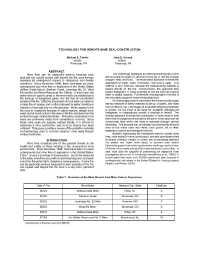Mining Publication: Technology for Remote Mine Seal Construction
Original creation date: February 2002
Mine fires can be especially perilous because toxic products can quickly spread well beyond the fire zone thereby exposing all underground miners to dangerous and deadly conditions. Since November 1998, there have been six major underground coal mine fires or explosions in the United States (Willow Creek (twice), Sanbom Creek, Loveridge No. 22, West Elk and the Jim Walter Resources No. 5 Mine). In each case, the entire mine or specific areas of the mine had to be sealed due to the build-up of dangerous gases and the fear of uncontrolled spread of the fire. Effective placement of mine seals can deprive a mine fire of oxygen and is often followed by water flooding or injection of inert gas into the affected area. When access to the fire zone is impossible because of safety reasons, airtight mine seals can be constructed, in the area of the fire, remotely from the surface through vertical boreholes. Remotely constructed mine seals are commonly made from cementitious material. Since these mine seals are typically erected blindly, it is difficult to determine if mine roof-to-floor and rib-to-rib closure has been obtained. This paper provides a review of the available materials and technology used to remotely construct mine seals through vertical boreholes.
Authors: MA Trevits, JE Urosek
Conference Paper - February 2002
NIOSHTIC2 Number: 20023181
2002 SME Annual Meeting, Feb 25-27, Phoenix, Arizona, preprint 02-185. Littleton, CO: Society for Mining, Metallurgy, and Exploration, Inc., 2002 Feb; :1-4
See Also
- Analysis of Mine Fires for All U.S. Underground and Surface Coal Mining Categories: 1990-1999
- Analysis of Underground Coal Mine Fire Incidents in the United States from 1978 through 1992
- CFD Modeling of Fire Spread Along Combustibles in a Mine Entry
- Fire Response Preparedness for Underground Mines
- Overview of U.S. Research on Three Approaches to Ensuring That Coal Miners Work Safely: Management, Workplace Design and Training
- Research Report on Refuge Alternatives for Underground Coal Mines
- The Status of Mine Fire Research in the United States
- Technology News 535 - NIOSH Releases New Educational Video: Escape from Farmington No. 9: An Oral History
- An Underground Coal Mine Fire Preparedness and Response Checklist: The Instrument
- Underground Coal Mining Injury: A Look at How Age and Experience Relate to Days Lost from Work Following an Injury
- Page last reviewed: 9/21/2012
- Page last updated: 9/21/2012
- Content source: National Institute for Occupational Safety and Health, Mining Program


 ShareCompartir
ShareCompartir
